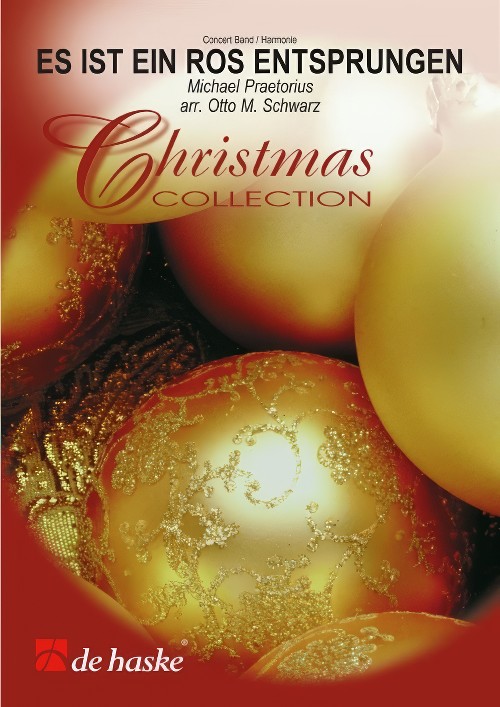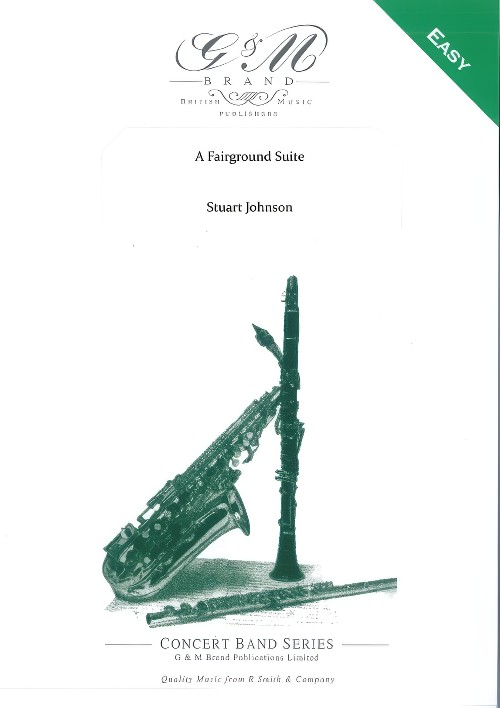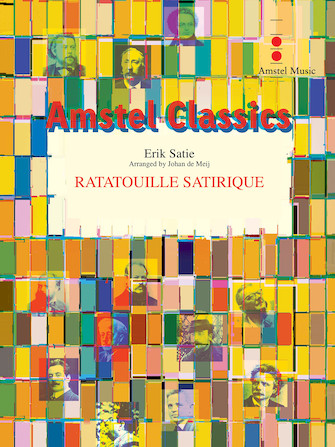Results
-
 £84.99
£84.99Es ist ein Ros Entsprungen (Concert Band - Score and Parts) - Praetorius, Michael - Schwarz, Otto M.
The many sided and productive Michael Praetorius (1571-1621) is known as a composer of dance music, sacred music and music for the advent and Christmas time. He worked as Kapelmeister to the court at Wolffenbuttel, but he was also asked to serve in other places, including Dresden. Praetorius was valued for the new impulses he gave to music by means of his use of instrumental accompaniment. His main contribution is his theoretical work "Syntagma Musicum", one of the most important musical reference books, in connection with instruments and instrumentation in the early 17th Century. "Es ist ein ros entsprungen" is a well known ancient melody which has inspired numerous composers and arrangers throughout the Centuries. Otto M. Schwarz has made a choral arrangement.Duration: 3:00
Estimated dispatch 7-14 working days
-
 £74.95
£74.95A Fairground Suite (Concert Band - Score and Parts) - Johnson, Stuart
One of Johnson, Stuarts most popular works for concert band is A Circus Suite, and he has often been asked to write a sequel. During a trip to a fairground with his children he was treated to a succession of rides, perhaps more for their benefit than his own, but during this entertaining afternoon he was alerted to the musical possibilities of each. His evocative musical descriptions offer everyone a chance of sharing the fun of the fair, and give the percussion plenty of opportunities to contribute, not all of them in a conventional manner!
Estimated dispatch 7-14 working days
-
 £14.95
£14.95A Fairground Suite (Concert Band - Score Only) - Johnson, Stuart
One of Johnson, Stuarts most popular works for concert band is A Circus Suite, and he has often been asked to write a sequel. During a trip to a fairground with his children he was treated to a succession of rides, perhaps more for their benefit than his own, but during this entertaining afternoon he was alerted to the musical possibilities of each. His evocative musical descriptions offer everyone a chance of sharing the fun of the fair, and give the percussion plenty of opportunities to contribute, not all of them in a conventional manner!
Estimated dispatch 7-14 working days
-
 £128.00
£128.00Ratatouille Satirique (Concert Band - Score and Parts) - Satie, Erik - De Meij, Johan
Erik Satie, born in Honfleur in Normandy (France) in 1866 is undoubtedly one of the most striking personalities in the history of French music. He composed in various, often quite divergent, styles. Besides light-hearted, entertaining works he also wrote several serious compositions, among which the three ballets: Parade, Rel che and Les Aventures de Mercure. However his piano pieces, such as Trois Gymnopedies or Gnossiennes will remain his most popular compositions. Satie co-operated with almost all great artists of his time: Pablo Picasso, Jean Cocteau, Sergej Diaghilev and Georges Braque and the composers Darius Milhaud (Le Groupe des Six) and Claude Debussy. Johan de Meij made an orchestration of three short pieces by Erik Satie: I. Prelude (from: Jack in the Box) II. Reverie (from: Trois petites pieces montees) III. Marche: Le Piccadilly (1904) It was only after Satie's death in 1925 that the manuscript of the piano piece Jack in the Box was recovered. Satie himself thought he had lost the manuscript in a bus. When his flat in Arceuil was cleaned out, a small notebook was discovered behind his piano and it contained the manuscript which was assumed to be lost forever. The R?verie (De l'Enfance de Pantagruel) is an extract from Trois petites pieces montees, originally composed for small symphony orchestra. In this suite it is meant as a restful intermezzo. It is clear that, as with Milhaud (La Creation du Monde) and Debussy (Golliwogg's Cakewalk; Le Petit Negre), it is hard to deny obvious influences of jazz music in Erik Satie's compositions. Le Piccadilly, dating from 1904, displays a lot of similarities with the compositions of Scott Joplin. Duration: 7.00
Estimated dispatch 7-14 working days
-
 £104.99
£104.99Ceremonial March (Concert Band - Score and Parts) - Van der Roost, Jan
In the course of the two centuries following the death of Henry Purcell in 1695, no British composer of any statue was apparent. Consequently, the break-through of Edward Elgar (1857-1934) as an internationally known and respected composer at the end of the last century, was of considerable importance. As a composer Elgar was largely self-taught and he looked towards the continent for his inspiration. He is without doubt on par with his contemporaries such as the somewhat younger Richard Strauss. The Belgian composer Jan Van der Roost is a genuine admirer of Elgar's music and on the occasion of the fiftieth anniversary of the composer's death in 1984 he composed the "Ceremonial March". Van der Roost was inspired by the most famous and frequently played works from Elgar's catalogue of works, the characteristic "Pomp and Circumstances" marches, and decided to add his own, sixth march to the existing collection.Duration: 5:30
Estimated dispatch 7-14 working days
-
 £71.28
£71.28A Kind And Gentle Soul
This prolific composer has penned many beautiful pieces. On this occasion, he has created yet another powerful and expressive composition that is highly reflective in nature. Composed in honor of a young boy who passed away far too soon, this emotional work is scored to evoke the kind traits that he displayed to the many people whose lives he touched. Truly inspiring!
Estimated dispatch 7-14 working days
-
 £144.99
£144.99Andante & Rondo Wind Band Set (Score & Parts)
Antonio Capuzzi (August 1, 1755 - March 28, 1818) was an Italian violinist and composer who studied violin with Nazari and composition with Bertoni. In 1805 he moved to Bergamo, where he was professor of violin at the Instituto Musicale and leader of the orchestra at Teatro Riccardi. He was highly regarded there both as a teacher and a performer. Although popular in his day, most of his music is now forgotten; his most commonly performed piece today is the Concerto for Double Bass. All of Capuzzi's known compositions were written during his Venetian years. It was in Venice that Capuzzi became close friends with Domenico Dragonetti, Beethoven's virtuoso bassist. It is speculated that Capuzzi wrote his Concerto for Double Bass for Dragonetti. Gerald Oswald has made a fine arrangement of the second (Andante) and third (Rondo) movements of the concerto to feature either euphonium or tuba with concert band. The solo part is also available in an edition with piano accompaniment. 09:05
Estimated dispatch 7-14 working days
-
 £89.99
£89.99Auld Lang Syne Wind Band Set (Score & Parts)
Whereas 'Auld Lang Syne' may be considered the best-known Scottish song ever, yet at the same time it is an obscure one, for there are but few people who know the complete text by heart. After the familiar 'Should auld acquaintance be forgot .....' many people take their refuge to lyrics like 'rum tee dum ta dee ..... lah, lah, lah ........... for auld lang syne'. Even in Scotland only a handful of persons know the entire text and are able to give a correct rendering of it. The current lyrics have been attributed to the Scottish poet Robert Burns. Burns, however, he did not write the whole poem : after he had heard an old man sing the centuries-old Scotch ballad, he wrote it down and added a number of stanzas (1788). Historical research teaches us that the ballad served many purposes, both political and religious. Nowadays, 'Auld Lang Syne' is sung as a Christmas Carol and it is also sung on New Year's Eve at the turning of the year. Apart from that, though, the song is also sung on many other occasions - sometimes with different lyrics, which usually have Love, Friendship and/or Parting as their themes, as these go well with the fascinating melody. In this arrangement a low-sounding solo instrument is central. The harmonization in the accompaniment fits in perfectly with the sentiments this song will evoke. Should auld acquaintance be forgot And never brought to mind? Should auld acquintance be forgot. And days of auld lang syne? For auld lang syne, my dear, For auld lang syne, We'll take a cup of kindness yet, For auld lang syne. 03:00
Estimated dispatch 7-14 working days
-
 £89.99
£89.99Copernicus (Concert Band - Score and Parts)
Polish academic Nicolaus Copernicus was a genius, excelling in the fields of mathematics, physics, law and astronomy. He is most remembered for his then revolutionary model of the solar system. Going against the grain, he put forward the idea that the sun, and not the earth, was the focal point of our solar system and all the planets revolve around it. Despite the initial uproar his ideas caused, he revolutionised science during the 15th century. His influence can still be felt today and despite being separated by many centuries, Copernicus inspired composer Johan Nijs to write this exciting piece for concert band. 05:40
Estimated dispatch 7-14 working days
-
 £94.99
£94.99Czardas (Clarinet solo) Wind Band Set (Score & Parts) - Monti, Vittorio
Vittorio Monti was born on January 6, 1868 in Naples (Italy). His musical education (violin and composition), he enjoyed at the conservatory there. Around his 30's Monti went to Paris. He earned a living as a conductor and wrote several ballets and operettas. In his last years, Monti died in 1922, he devoted himself to teaching and composing. His famous "Czardas" has made his name known even today. Initially the czardas was a Hungarian folk dance , but after the mid-nineteenth century it was even a dance for the upper-class. Czardas begins with a slow introduction, the Lassan (slow and sad), and then the fast part, Friska, follows. Czardas is not, as so many people think typical gypsy music. 05:30
Estimated dispatch 7-14 working days
